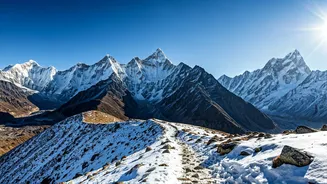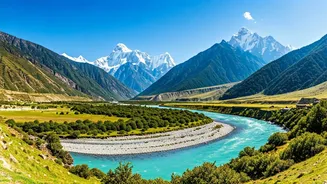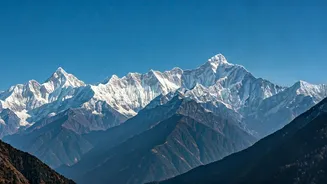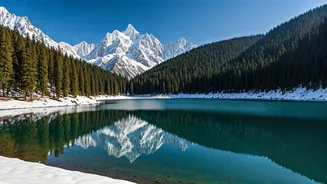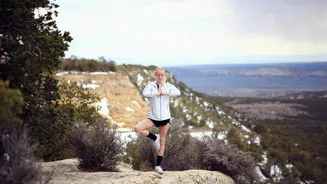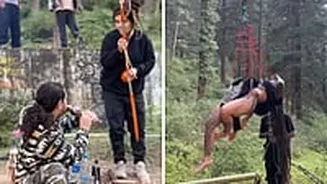Embrace Winter's Charm
Winter treks offer a unique perspective on the mountains. The landscape transforms into a magical wonderland, draped in white and sparkling with sunlight.
The crisp air and the quiet stillness of the snow-covered trails offer a refreshing escape from the hustle of everyday life. However, winter trekking is considerably different from summer trekking. Conditions can change rapidly, with fluctuating temperatures, snowstorms, and icy trails. These challenges are part of the adventure, making the experience more rewarding and memorable. Before starting, it is crucial to research your chosen trek thoroughly and check weather forecasts and trail conditions. Having the right gear and making adequate preparation is paramount to ensure safety and enjoyment.
Essential Gear Checklist
Choosing the correct gear is vital for a safe and enjoyable winter trek. The layering system is essential; start with moisture-wicking base layers, add insulating mid-layers like fleece or down, and finish with a waterproof and windproof outer shell. Sturdy, insulated, waterproof hiking boots are also a must. Proper traction is critical; consider crampons or microspikes for icy sections. Other necessary items include warm socks, a hat, gloves or mittens, a scarf or neck gaiter, and sunglasses or goggles to protect your eyes from the sun and snow glare. A backpack to carry your essentials, a water bottle or hydration reservoir, high-energy snacks, a first-aid kit, a headlamp or flashlight, and a map and compass or GPS device are also essential. Packing extra layers and emergency supplies is always wise. Finally, remember to bring sunscreen and lip balm, as the sun's intensity is higher at higher altitudes.
Prioritize Physical Fitness
Winter trekking demands a good level of physical fitness. Regular exercise leading up to your trek is crucial for building stamina and strength. Start with cardiovascular exercises like running, swimming, or cycling to improve your endurance. Incorporate strength training exercises to build muscles, especially in your legs, core, and back. Practice hiking with a weighted backpack to get used to carrying the gear. It's also important to get your body acclimatized to the altitude, especially if you're trekking in the Himalayas. Spend a few days at a higher elevation before your trek to allow your body to adjust. During your trek, pace yourself and take breaks as needed. Listen to your body and don’t push yourself too hard. Proper nutrition and hydration are also very important for maintaining energy levels and preventing altitude sickness. Stay well-hydrated and consume energy-rich foods throughout your trek.
Kedarkantha Trek
The Kedarkantha trek in Uttarakhand is a popular choice for beginners due to its relatively easy ascent and stunning views. The trek typically spans over 6 days, starting from Sankri and traversing through dense pine forests and snow-covered meadows. The trail is well-defined, and the climb is gradual, making it suitable for those new to winter trekking. The summit offers panoramic views of the Himalayas, including peaks like Swargarohini, Bandarpoonch, and Black Peak. The best time to trek Kedarkantha is from December to April when the area is covered in snow. The trek provides a moderate level of difficulty, covering approximately 20-25 km in total. The experience includes camping in the snow and immersing oneself in the serenity of the mountain environment.
Triund Trek
Triund, located in Himachal Pradesh, is another excellent option for beginners, providing a short but rewarding trek. The trek starts from McLeod Ganj and ascends through a scenic trail, offering breathtaking views of the Dhauladhar range. It is a relatively easy trek, typically completed in a single day, making it suitable for those with limited time or experience. The summit of Triund offers a stunning panorama of the Dhauladhar mountains on one side and the Kangra valley on the other. The best time to trek Triund is from March to December when the weather is pleasant, and the trails are accessible. The trek is approximately 9 km long and involves a moderate climb, making it a great introduction to Himalayan trekking. It's a great choice for a day or overnight trip to experience the mountains.
Bhrigu Lake Trek
Bhrigu Lake, nestled near Manali in Himachal Pradesh, is a high-altitude alpine lake known for its breathtaking beauty and relatively accessible trail. The trek is considered moderately challenging and typically takes 3-4 days. The trail passes through lush meadows, alpine forests, and offers stunning views of the surrounding peaks. The lake, at an altitude of approximately 14,100 feet, is believed to be sacred and is surrounded by snow-capped mountains. The best time to undertake the Bhrigu Lake trek is from May to October. The trek includes a mix of gentle slopes and steep climbs, making it moderately challenging but rewarding. Proper acclimatization is crucial due to the high altitude. It is an ideal trek to appreciate the raw beauty of the Himalayas and challenge oneself with a high-altitude experience.
Chandrashila Trek
The Chandrashila trek in Uttarakhand is a classic winter trek offering unparalleled views of the Himalayas. The trek culminates at the Chandrashila peak, which can be reached via Chopta. The trek typically covers 5-6 days. The trail is known for its well-defined paths and the opportunity to visit the Tungnath temple, one of the highest Shiva temples in the world. The summit provides a 360-degree view of the Himalayan peaks. The best time to trek Chandrashila is from December to April, when the area is covered in snow. The trek involves a moderate level of difficulty and is accessible to beginners with a good level of fitness. It combines the thrill of a high-altitude climb with the spiritual experience of visiting a revered temple. The stunning vistas and crisp mountain air make it an unforgettable experience.


